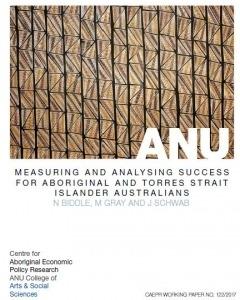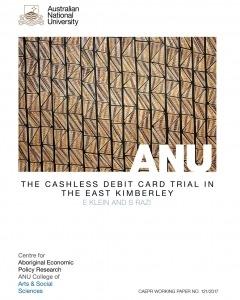Indigenous participation in arts and cultural expression, and the relationship with wellbeing:results from the 2014-15 National Aboriginal and Torres Strait Islander Social Survey
Author/editor: Nicholas Biddle and Heather Crawford
Paper no: 117
Year published: 2017
The analysis presented in this report shows that, among Aboriginal and Torres Strait Islander people, better outcomes for socioeconomic indicators such as employment, education and income are positively associated with participation in arts and cultural expression. There is also strong evidence…

Measuring and analysing success for Aboriginal and Torres Strait Islander Australians
Author/editor: Nicholas Biddle, Matthew Gray & Jerry Schwab
Paper no: 122
Year published: 2017
The Closing the Gap targets feature heavily in the current policy measurement framework for Aboriginal and Torres Strait Islander Australians at both the national and state/territory levels. The targets provide concrete measures against which trends in changes in outcomes for the Indigenous…
Occupational Mobility of Indigenous and other Australians, 2006-11
Author/editor: Hunter,B & Gray,M
Paper no: 118
Year published: 2017
This paper describes Indigenous and non-Indigenous occupational mobility (i.e. changes in the skill level of an occupation in which an individual is employed) using the Australian Census Longitudinal Dataset, 2006-11. The paper also considers movements out of paid employment, by occupation, and the…

The Cashless Debit Card trial in the East Kimberley
Author/editor: Klein, E & Razi, S
Paper no: 121/2017
Year published: 2017
This paper focuses on the Cashless Debit Card trial in the East Kimberley, Western Australia. The card aims to restrict cash and purchases to curb alcohol consumption, illegal drug use and gambling. The card targets Indigenous people disproportionately – 82.0% of the people in the East Kimberley…
The Characteristics and Potential Effects of the Schools that Indigenous Australians Attend
Author/editor: Biddle, N & Edwards, B
Paper no: 119
Year published: 2017
This paper uses data from the National Assessment Program, Literacy and Numeracy (NAPLAN) to document the distribution of Indigenous students across Australian schools, as well as some of the potential effects of that distribution on literacy and numeracy outcomes. The results show three main…
The comparative wellbeing of the New Zealand Māori and Indigenous Australian populations since 2000
Author/editor: Gray, M & Hunter, B
Paper no: 116
Year published: 2017
Some researchers have argued that strong periods of economic growth and economic downturns have a greater impact on the economic position of the Indigenous population than the non-Indigenous population in settler societies such as Australia and New Zealand. Māori have significantly higher levels of…
Vocational Education Participation and Attainment Among Aboriginal and Torres Strait Islander Australians: Trends 2002-2015 and Employment Outcomes
Author/editor: Crawford, H, Biddle, N
Paper no: 114
Year published: 2017
This report examines trends in participation in vocational education and training, and attainment of vocational qualifications, among Aboriginal and Torres Strait Islander people during 2002–15. The report also investigates whether Aboriginal and Torres Strait Islander people with a higher-level…